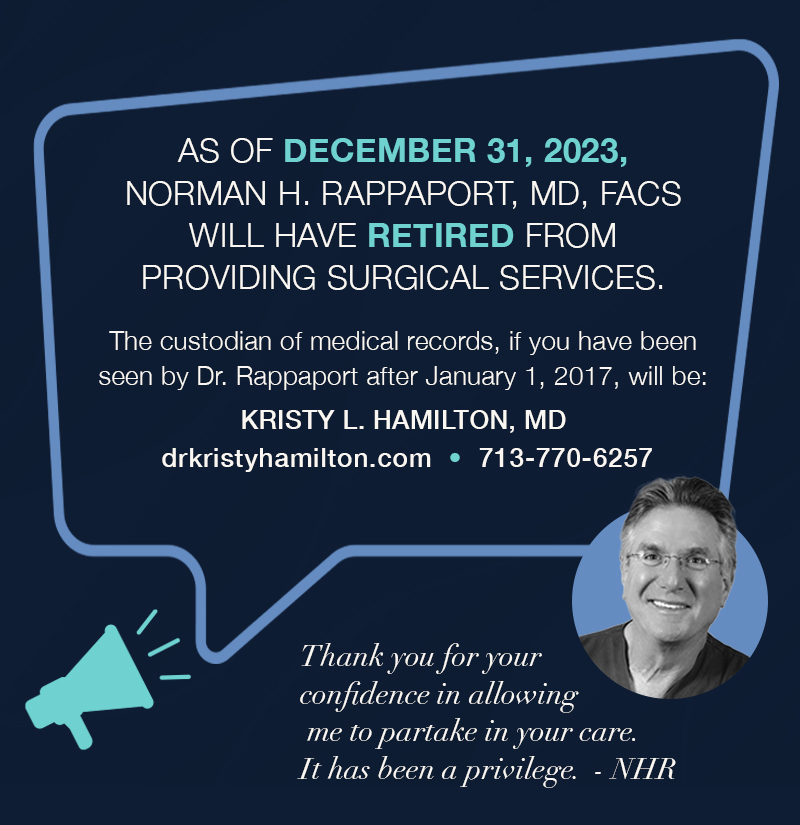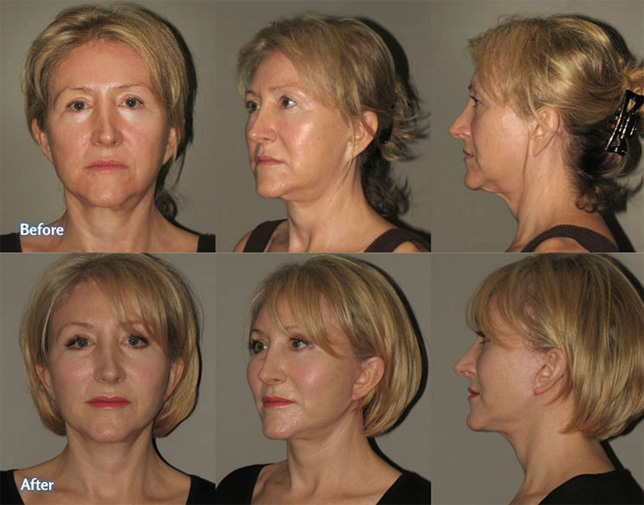Facelift Houston
A face lift, or rhytidectomy, is a surgical procedure to counter the effects of gravity that lead to a worn, aged appearance. Dr. Rappaport performs a number of variations on his face lift procedures to customize surgery to the unique needs of each his patients. During your personal consultation, he will recommend the best technique suited to your concerns and desired outcome. In some cases, he may advise a combination of a face lift with a brow lift, eyelid lift or chin implant and/or advancement to achieve the best possible results for you.
A face lift offers the following benefits:
- Reduction in the appearance of deep lines and folds
- Restoration of youthful volume in the cheek area
- Improved definition to the jawline with the elimination of “jowling”
- Elimination of bands or excess skin under the chin
Facelift Surgery Houston
Options in Facelifts
Dr. Rappaport performs two types of face lifts:
- Mid-Facelift – This procedure, which addresses the cheeks and outer corners of the nose and mouth, can be done alone or in combination with a standard face lift. The mid-face lift gets rid of sagging cheeks and eases the transition from the lower eyelid to the cheekbone.
- Standard Facelift – The standard lift rejuvenates the lower two-thirds of the face, from the cheekbones to the jawline. The neck may also be included in this procedure, extending the benefits from the jawline to the Adam’s apple.
How is a Facelift Performed?
A facelift is typically performed under general anesthesia and often can be done on an outpatient basis. Incisions for the procedure are strategically places in the natural contour of the ear or within the hairline, so post-surgical scarring is nearly minimal. Depending on the specific procedure you have, he may choose one of these incisions options:
A standard incision begins in the front of the ear and goes around the earlobe and into the hairline at the back of the neck.
A short-scar incision begins in front of the ear and goes around the earlobe like a standard incision, but does not extend to the back of the neck.
Through the incisions, Houston Facelift Surgeon Dr. Rappaport does corrective lifting and supporting of the facial structure to produce natural results. The skin is then carefully re-draped without tension to prevent the “windswept” look of face lifts past. His technique also reduces the risk of tissue loss and poor scarring, for the best possible outcome.
What is Facelift Recovery Like?
There is some swelling and bruising after a facelift, which will subside in the first couple of weeks after the procedure. Dr. Rappaport usually tells his Houston facelift patients that they will be ready to “see your best friends in about 10 days and your worst enemies in about two weeks.” Most patients will be ready to return to light activities within that timeframe, although more strenuous activity may be restricted longer to give the face ample time to heal.
Dr. Rappaport Answers Questions about Facelifts
If I have sagging skin around my eyes, will a facelift correct them?
Depending on the degree of sagging around your eyes, I may recommend that we combine a facelift with a brow lift and/or eyelid surgery procedure. These are very complementary procedures.
Will a facelift help correct sagging in my jawline and neck?
A facelift will help correct jowling. If you have bands under your neck, I can also make an incision under the chin to tighten the muscle causing the bands. I may also use liposuction to remove excess fat in the neck. A chin implant or chin advancement can sometimes help improve the angle of the jawline. In younger patients, liposuction alone may be sufficient to correct the neck.
Do you also perform facelifts on men?
Yes. Although 90% of my patients are women, more men are now requesting this procedure. In fact, according to the American Society of Plastic Surgeons, face lifts are one of the most popular surgical procedures for men today, with more than 12,000 men seeking the procedure in 2013.
Where is the actual lifting done in a facelift?
A facelift is not a matter of simply tightening the skin. The ‘lifting’ is done by manipulating the superficial musculoaponeurotic system, or SMAS—an anatomical layer below the skin, but above the functional structures of your face. This strong layer of tissue adds support to your facial features.
Are there different techniques of working with the SMAS?
Yes. Depending on the amount of lifting your face needs, I may use one of three techniques:
- Imbrication – In this technique, the SMAS is lifted and imbricated, or overlapped like a soft pleat, and secured by stitches.
- Flap development – In this technique, we’re creating a flap of tissue in the SMAS that I can then rotate and/or advance to contour your facial structures.
- “SMASectomy” – This technique involves removing a portion of the SMAS from the jawbone to the cheekbone, and produces a tightening effect in the middle of the cheek.”
Which technique do you prefer for mid-facelifts?
I often use a new device called an Endotine®TM to perform a minimally invasive mid-face lift to elevate facial tissue back up on the cheekbones. I place the Endotine®, a bio-absorbable implanted device with five tiny fork-like tines, at a 45-degree angle on the cheekbone, and lift the tissue onto it. In the six to 12 months it takes for the Endotine® to dissolve, the tissue has time to re-attach to the cheekbone. This secures the tissues and enables them to maintain their new, lifted position.
Where are the incisions for an Endotine® facelift?
An Endotine® face lift is done through a small incision in the hairline and another small incision in the mouth or through the lower eyelid.
How does an Endotine® lift compare with a mini-facelift?
There are a number of ‘brand-name’ face lifts being advertised in the media — but the hardest thing in plastic surgery is to compare one procedure to another. A lot has to do with the individual surgeon. However, there are some office-based face lift techniques that don’t last as long simply because they don’t address the primary anatomical problem.
Does having a facelift mean I won’t need facial fillers?
No. Once you have corrected the effects of gravity with a facelift, facial fillers can help you maintain youthful volume—a very important component in a younger-looking face. BOTOX® can also help by relaxing the muscles that cause frown lines. I also use BOTOX® to lift the corners of the mouth and to create a subtle brow lift.
How can I maintain the results of my facelift?
Clinical skin care — both at home and in our office — can help you maximize the effects of your facelift by giving you a smooth, dewy complexion that radiates youthfulness.
Interested in learning more about your options in facelift surgery? Contact Houston Center for Plastic Surgery at 713-790-4500.
6560 Fannin Street, #1812
Houston, Texas 77030
Phone: (713) 790-4500
Fax: (713) 793-1299
Email: info@hcps.cc


